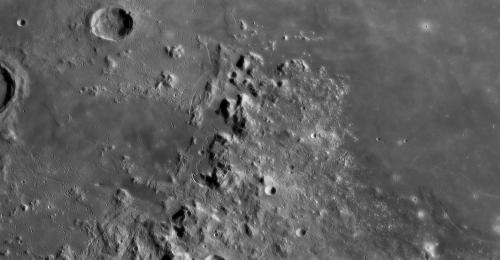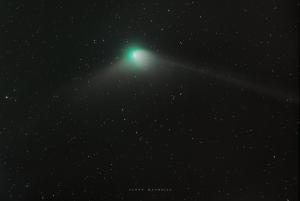Celebration of Space - February 3, 2023

Hadley crater, rill, and mountain where the Apollo 15 mission landed. Credit: Scott MacNeill captured this at Brown University's Ladd Observatory.
On Sunday, February 5, 2023, at 1:31 pm, the Moon will reach the point in its orbit where it is on the opposite side of the Earth than the Sun. We call this opposition, but you have probably heard it called The Full Moon. Like the full Moon of January, this full phase will occur close to the lunar apogee, which is when the Moon is the furthest from Earth during its 27.3 day orbit. Since apogee occurs at 2:57 am on February 4th, we would not consider this a Micromoon, though many probably will.
The February full Moon carries the moniker The Full Snow Moon. For Southern New England this totally fits because February is the height of nor'easter season for us, which usually brings a significant amount of snow. In 2023, we have had a rather wet and warm winter (well, aside from today) in Southern New England. So, no snow for the Snow Moon. Other names that the February Moon goes by are the Bear Moon, Eagle Moon, and Groundhog Moon. Regardless of what you call the February Moon, be sure to step outside on Sunday night just after sunset and look to the ENE to catch a view of the rising Snow Moon.
Over the past week we have received a slew of write-ins about Comet C/2022 E3 ZTF. At Frosty Drew Observatory, we had our first look at the famous comet last Friday, January 27th, and were a bit disappointed because the comet is not all that spectacular. Certainly not the fabled beast that the media has hyped it to be. But the view is nice. In the telescope the atmosphere (coma) and nucleus are quite visible, and with careful attention a hint of the ion tail is visible as well. Many visitors had a chance to observe the comet, but most that did were rather upset that they weren’t seeing what they had been led to expect.
The comet made its closest pass to Earth on February 1, 2023 at a distance of 26 million miles. This would have been the best night to catch a view, because it would have appeared the brightest in the sky, but the Moon is approaching full, and like all dim objects, the Moon certainly outshines the view. At Frosty Drew, we are expecting best views of the comet to happen after February 7, 2023. This is because the Moon will depart the evening sky, quickly retreating into the morning sky. Now that the comet has passed Earth, it is very visible in the evening sky, after twilight wanes. On February 8, 2023 the comet will be in the constellation Auriga, which is almost directly overhead in the evening. On February 9th, the comet will move into the constellation Taurus, with the comet visibly coming within 1º of Mars on February 10th. These will likely be the best times to get out and see the comet. Even after that, the lack of a Moon will make the sky dark enough to get some beautiful views of the comet in binoculars.
On Saturday morning, January 28, 2023, we were able to capture a stunning image of the comet. The image clearly shows the green atmosphere (coma), with a rather wide dust tail, slim ion tail, and an anti-tail streaming off to the left. Check out our image of the comet here.
On Thursday, February 2, 2023, Groundhog Day occurred. Many people associate this day with the humorous story of a groundhog in Pennsylvania emerging to see its shadow or not. But Groundhog Day is actually an astronomical occurrence. It is one of the four cross quarter days of the year. Cross quarter days mark the halfway point between the equinoxes and solstices. As of today, we are officially on the down stroke, or second half of winter. The Vernal Equinox will occur on March 20, 2023, and will mark the first day of the spring season in the Northern Hemisphere. Other cross quarter days of the year include May Day in May, Lammas in August, and Halloween in October. So take a bit of solace that the winter is coming to a close, and beach days are slowly approaching.
Evening passes of the International Space Station (ISS) are coming to an end this weekend, though a few passes remain, with one rather good pass. Once the station departs the evening sky, we will have a short period with no visible passes, but it will return to our view in the morning sky shortly after. Here are the remaining evening passes of the ISS:
Fri, Feb 3 at 6:45 pm, starting in the WNW, rising to 24º, heading towards the S, and into orbital sunset
Sat, Feb 4 at 5:56 pm, starting in the WNW, rising to 42º, heading towards the SSE
Mon, Feb 6 at 5:56 pm, starting in the W, rising to 15º, heading towards the S
Set your alarms to catch these final passes of the ISS in the evening until it returns in mid-March.
- Author:
- Scott MacNeill
- Entry Date:
- Feb 3, 2023
- Published Under:
- Scott MacNeill's Columns



